By: Nancy Marino
Senior Vice President, Tompkins International
Chief Development Officer, The MonarchFx Alliance
Executive Summary
Economic, political, and environmental challenges combined with the growing complexity of global operations have made Integrated Business Planning (IBP) a top corporate priority. Indeed, the potential is tremendous in the most volatile business climates. This process aligns merchandising, sales, planning, Research & Development (R&D), operations, finance, and other functional areas of the organization, into a single line of sight, from plan to performance to profit.
Internal alignment is just part of the Integrated Business Planning (IBP) process to create company agility that can recognize, recalibrate, and respond to changing conditions. It is equally critical, in the face of today’s highly outsourced and distributed supply chain, where businesses enable collaborative inputs from customers and suppliers in their planning process. According to leading research from Gartner, the majority of Consumer Packaged Goods (CPG), global retailers, and manufacturers are looking to advance their current Sales & Operations Planning (S&OP) initiatives to also include a full view of the financial impacts of their supply and demand balancing options to inform better and make timelier strategic decisions. It is this journey to true IBP, which allows strategic, bottom-line oriented “what if” scenario modeling, and must be managed by a strategic process which can move at the pace of today’s global business environment. These two processes are intricately connected and create the “company dialogue” that enables the business to understand and be lead by a common vision of the core values and objectives.
In this paper, we take a look at how innovative Integrated Business Planning (IBP) can help drive the right process and the best business value in an environment where volatility is the “new normal”.
At what point did S&OP become IBP? S&OP was failing to get the attention of the executive, as it does not resonate with business leaders while IBP does. IBP resolves the issues that companies have around integrating and organizing people within their businesses. The objective is to get everybody driving to the same plan as quickly as possible. The purpose of an effective S&OP process has always been to achieve alignment for the supply chain logistics, procurement, sourcing, and production, to sales, operations, IT, and finance while, IBP aligns sales, merchandising, marketing, R&D, operations, supply chain, finance, HR, and IT. S&OP is designed to find and react to supply chain gaps and by its’ process is reactionary.
IBP sits at the heart of many organizations as the management process that runs the entire business. The real power of IBP is in enabling effective decision making to control the future direction of the company. It makes the critical link between strategic plans and the current reality, acting as an early warning system for performance gaps. IBP gives senior management an accurate holistic view of the business over a 24 to 36 month horizon. Unforeseen events can be detected early and be addressed with speed and agility, through planned actions rather than fire fighting; being proactive rather than re-active, and is designed to align the organization for growth and its’ strategic objectives.
S&OP has done much to enhance the efficiency and profitability of supply chains in virtually every industry, but this process needs to be not just a supply chain process, but rather and end-to-end business view. IBP helps finance, R&D, merchandisers, planners, marketers, the supply chain, and strategic partners to take the next step forward. Rather than enhancing supply chain processes in isolation, IBP seeks to involve a wide range of stakeholders in every operational decision, so that the supply chain can truly drive the success of the entire business.
In the simplest of terms, the IBP reconciles and harmonizes strategy and execution by aligning strategic plans into operational plans and bringing the practical aspects of execution (constraints, capacity availability, realistic throughput rates that have been achieved, detailed unit costing, and profitability) into the creation of strategic plans. The outcome of IBP is a true business plan, rather than a demand plan, supply plan, production plan, or a financial budget. Through IBP, enterprises gain a single holistic plan that unifies the business, seamlessly connecting corporate performance management, financial planning processes, and operational planning systems. This holistic business plan increases business alignment through the sharing of performance strategies and helps quantify business risks, enabling enterprises to rapidly adapt to meet challenges.
From S&OP to IBP
Every organization has a number of processes in place, but there is also likely to be a certain amount of inertia because people are used to doing things in certain ways. Sure, people may agree that some improvement may be possible, but without seeing the big picture they do not see the need for change.
At its core, the IBP takes rigid, independent processes and transforms them into flexible, choreographed business services that work together to create substantial business value. This transformation can help an organization to adapt to an ever faster changing business climate and global economic challenge. Rarely, companies have an entire market all to themselves. Indeed, most enterprises are facing ever-increasing competition.
The basic operational value proposition of IBP is the ability to process more with less effort and with higher quality. As a result, IBP has become a cornerstone discipline for companies that want to grow revenues quickly, while controlling resource costs. Business processes are pervasive in any organization. These processes represent all the activities that organizations in all industries undertake. Some processes are highly structured, such as high-volume manufacturing processes, while others, such as medical care that must be tailored to specific patients’ needs, are more unstructured.
You may not think of the activities performed within your organization as business processes, but that is exactly what they are. As you try to improve your operations, you are engaging in a process improvement project. Clearly, you want to leverage advanced methodologies and technologies to deliver consistent, repeatable, and more efficient outcomes, as you work on this improvement project. IBP helps you define and manage your business processes, to reach your desired business goals.
S&OP and IBP Process Differentiation
|
Topic |
S&OP |
IBP |
|
Objective |
Balance Supply & Demand |
End-to-End Business Planning |
|
Leader |
C-Level, or CSCO |
CEO & COO |
|
Cycle |
Monthly on Fixed Calendar |
Monthly as Key Milestone |
|
Fixed Factors |
Forecasting & Supply Chain |
Total P&L Plan |
|
Participants |
Sales, Operations & Support |
All Business Leaders |
Definition of IBP
-
A process lead by senior management that evaluates and revises time-phased projections for demand, supply, product, portfolio changes, strategic projects, and the resulting financial plans. This is done on a monthly basis, typically over a 24 to 36 month rolling planning horizon.
-
It is a decision making process that realigns the tactical plans for all business functions in all geographies and operating units to support the company’s goals and objectives.
-
A primary objective of IBP is to reach a consensus on a single operating plan, to which executives of the management team hold themselves accountable and allocate the critical resources of people, equipment, inventory, materials,
time, and funding to most effectively satisfy customer profitably.
-
To insure that the process is integrated, marketing provides insights and by the nature of marketing that is planning two years out, helps to give a longer-term view to the IBP.
-
Input on competitive intelligence is managed proactively and is a critical input during the IBP management process.
Integrated Management Review Process
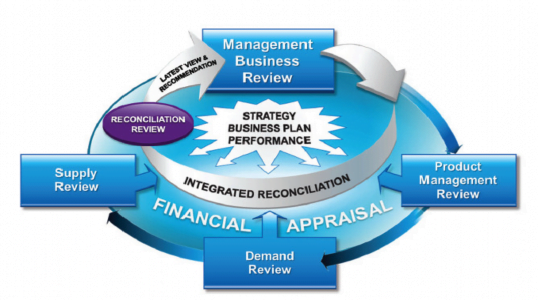
What are the key factors in establishing a successful IBP process?
-
Ownership: Ultimately everyone needs to be committed to IBP, but commitment begins at the top.
-
Business Horizon: Successful IBP requires the business to look out over 24 to 36 months and is critical that the horizon is rolling and the forward view is continually updated to compare performance against strategy.
-
Focus: The purpose of the IBP process is not to manage to the short term but to focus beyond and review the financial plan for gaps between the bottoms-up and top-down plan, while also reacting to current issues with a long term view.
-
Managing Behaviors: Transitioning from S&OP to IBP challenges the traditional thinking of operating in silos to integrating all areas. This requires a behavior change to execute to the consensus plan and communicate that plan to all stakeholders in a timely manner.
-
Keys to Success: Effective IBP requires the interaction of all stakeho ders supported by defined processes and roles and responsibilities. Behavior change comes from involving the right people, at the right time, in the right process, to achieve the right outcome.
Value Associated with IBP
While S&OP is a journey, IBP is a defined business process. Typically it begins with an improved demand signal to provide adequate reaction time for shifting sales opportunities. The next stage connects and aligns demand, supply, and capacity plans for improved service levels, as well as, capital and production resource utilization. The last stage extends the process to include key customers and suppliers and provides executive “what if” scenario modeling for operational decision-making. With every step in the journey businesses gain more control and agility.
Fully realized S&OP is being referred to and has become a best in class process, which is IBP. IBP takes S&OP to another level, by integrating financial systems data into the equation. This brings together strategic and operational planning for a single view from plan to performance to profit.
Embedded financials are central to S&OP value; however, robust what-if analyses can unleash S&OP’s maximum potential, and deliver true IBP. What-if analyses allow users to evaluate alternative strategies and policies to maximize revenue, profit, and working capital performance. Additionally, they aid in evaluating risk and supply chain constraints, as well as, meeting service level commitments.
Support for multi-dimensional analysis on a forward-looking basis is essential for maximizing value. Cross-functional analyses allow managers to approach planning from multiple business angles (e.g., availability, demand, product, supply) including upside and risk scenarios. This helps in quantifying key trade-offs, as well as, reaching a consensus on actions and policies to optimize future performance.
Demand and sales planning includes analyses of sales, pricing, promotions, specific customer needs, and serves to identify the impact of various shaping strategies on the business. This allows companies to maximize a combination of revenues, profits, and volumes. For demand and sales planning, a best practice analysis sequence would include the below elements of IBP.
-
A preliminary what-if analysis of the sales forecast, including factors like expected demand uplift, pricing, and any costs associated; examples of this include executing a trade promotion campaign or providing special deals for customers, which typically include a certain volume and pricing. Editing a demand plan through various scenarios usually does this.
-
Once the scenario is entered, users recreate the plan considering system constraints. By optimizing the supply plan for profit and cost, results can be compared to multiple scenarios to discern the best possible outcome. This saves significant time and allows for more realistic evaluations than simulation-based strategies.
-
The re-optimized plan establishes impacts on overall financial performance, including product and campaign profitability. Users are able to see Profit & Loss (P&L) according to business unit and product, as well as, the impact of the campaign compared to a base plan.
-
Root-cause analyses help to determine the key performance drivers. For example capacity availability may inhibit how well demands are met, or force overtime, and build-ahead (resulting in higher cost and lower campaign profitability). Additionally, users may find that their policies (such as working capital or inventory) drive higher out-of-stock situations.
As there is more to a business than just the alignment of supply to demand, IBP serves to ensure that the corporate assets are used to align capital investment and human investment to a long-term strategic objective. Through this clarity, short-term S&OP activities can be completed in a way that aligns to the longer strategic objectives.
IBP aligns those processes that set the business differentiators and strategic initiatives that require a long-term commitment to ensure that they are fully implemented new lines of business, competitive positioning, strategic sourcing direction, marketing direction, consumer touch points, and digital channel implementation goals. S&OP may raise long term positioning opportunities, but IBP puts the capital investment behind them to align the resources to get complex projects completed.
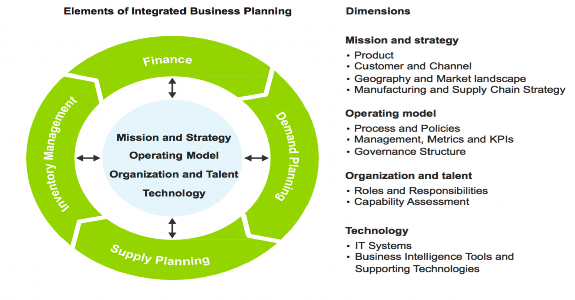
IBP Drives Operational Effectiveness and Agility
Operational effectiveness and agility, the ability to respond quickly to changing business requirements and market trends can be a strategic competitive advantage for your organization in supporting intelligent business operations. No matter what industry you operate in, you recognize that operational excellence and consistent execution of day- to-day business operations, significantly improves customer satisfaction that leads to long-term stability and business success. Research strongly suggests that companies can enhance the performance of their daily business operations by taking a “process view” of the organization.
Business process and value-stream orientation has proven to reduce interdepartmental conflicts, improve cross-functional collaboration, and significantly increase customer focus. The fast pace of modern business, a volatile competitive landscape, the explosion of information (both structured and unstructured) from multiple channels, and the demands from the consumer have a huge impact on business operations.
Departments can no longer work in isolation. Organizations have to move away from the splintered and silo views of business to “big-process-thinking,” which Forrester defines as follows, “Big process shifts the organization’s focus from isolated Business Process Management (BPM) and process improvement projects to a sustainable, enterprise-wide business process transformation program supported by top executives.” Big processes are complete business scenarios focused on delivering value to customers. From an organizational perspective, people from several departments typically collaborate to achieve common goals. These processes have a great impact on customer satisfaction and can be decisive in winning customer loyalty. They are typically high-value processes and have to be managed effectively to keep business operations running efficiently and at top performance. Key processes are closely linked to big data and acquire big data characteristics, such as high volume, high velocity, and variety of data and interaction (structured and unstructured). In addition, they are the “crown jewels,” supporting the key business operations of the company’s business.
Economic, political, and environmental challenges combined with the growing complexity of global operations have made IBP a top corporate priority.
IBP Process
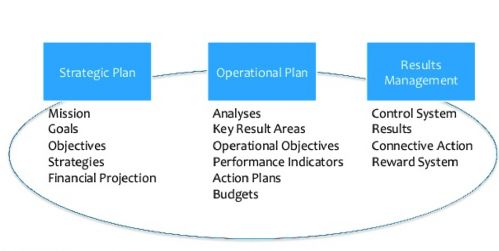
Nine Success Strategies for IBP
-
Engaging sales and marketing
The fundamental point that existing IBP processes fail to notice is that sales begins from a customer opportunity. Sales have traditionally focused primarily on opportunity conversion rather than build forecast. Traditional supply chain driven processes make the assumption that sales understands the build forecast best and thus can feed all the data the supply chain needs into their advanced planning system. This approach does not usually work.
The progression of supply chain models of build-to-stock, configure-to-order, and engineer-to-order reveals that they are increasingly more opportunity focused. The question becomes, why not use a Customer Relationship Management (CRM) system? Unfortunately, a CRM system is unsuitable because they do not have forecasting capabilities. A CRM system is a transactional system that manages accounts and takes sales through various stages of the lifecycle. What is needed is an IBP process that understands opportunities and the conversion to build forecasting. For successful IBP, engagement from merchandising and sales teams is critical. It needs to be a simple push driven process to establish successful engagement.
-
Linking the financial plan to the operational plan
The second key strategy for successful IBP is linking the financial plan to the operational plan. Financial integration with S&OP is often termed as IBP in the industry. It is our opinion that it is a narrow definition most often provided solely as a way to sell software. The financial considerations into IBP should not be done as an afterthought or a separate step. Financial parameters should be present throughout the process and be ubiquitous.
-
Cross-functional and multi-enterprise collaboration
IBP is not only about north-to-south integration of financials to operations, but also about left-to-right integration of functional groups as well as trading partners. Examples of cross-functional groups are R&D, merchandising, sales, finance, sourcing and production, logistics, operations, procurement, product management, etc. Examples of the multi-enterprise trading partners are customers, suppliers, Third Party Logistics (3PL) providers, supply chain finance providers, marketing, etc. In fact the concept of IBP has applicability across a wide spectrum of industries and functional areas.
-
Continuously align strategy with operations
Management teams (C-level Executives, General Managers, etc.) grapple with strategic issues like dealing with shifts in global markets, commodity shortages, and the impact on pricing, natural disasters, and Mergers &Acquisitions (M&A). An IBP process, where the strategic plan is also integrated with the operational plan can act as a sandbox for performing strategic scenario management. The assumptions associated with these scenarios should be captured for future reference and support the ability to create customized workflows that can address strategic goals and financial objectives.
-
Ensure process agility and flexibility through technology
Traditional software implementation tries to decouple process and change with technology deployment. We do not dispute the fact that process change is very important and pivotal to project success; however, the artificial decoupling of process and technology is done not, as a best practice, but due to limitations of existing technology.
Enterprise Resource Planning (ERP) and Supply Chain Management (SCM) solution providers have always lacked purposeful built S&OP platforms as part of their legacy. They have patched together a group of disparate software solutions, demand planning, supply planning, etc., for enabling the S&OP process. These solutions are akin to cement wherein once the software has been implemented it is extremely difficult to change the configuration. Also, the time it takes to configure and implement the solutions is often measured in years rather than months. The correct approach is to outline and implement the IBP process and strategy and if systems are needed to support the business they can then be matched to the business process. This also allows an organization to work through change management issues prior to implementing any software and preventing costly changes as the process was not vetted by the stakeholders and tested.
-
Capture metrics for performance management as part of the process
Decoupling the proliferation of business intelligence reporting, driven by silos that are not in sync with the needs of the IBP process, results in the lack of adherence or enforcement to the IBP process. Given that the key sensor for measuring process efficiency is the metric, it needs to be captured at the point or close to of the process. There should be an ability to support a standard library of metrics as well as provide the flexibility to create new metrics. The solution should be end-user driven rather than IT driven. End users should be able to create, modify, and manage metrics. An integrated dashboard with a combination of financial and operational metrics and optimized demand-supply-finance reporting reflects best in class IBP processes. The real-time or near real-time nature of these reports is compelling to the end-user.
-
Optimized demand-supply-finance balancing
Companies should adopt a crawl-walk-run approach towards optimization. Proceeding with an optimization project without setting up the basic process and workflows will inevitably result in failure. In addition, the evolution of supply chains into demand- supply networks results in a reduced impact of optimization-based techniques. There should be an ability to respond to changes in market events and take immediate action.
-
Eliminate information silos for greater efficiency
Achieve the full benefits of S&OP by embracing IBP. The demand workflow process provides tools needed to eliminate organizational silos, involving more colleagues and partners in supply chain decisions, and make faster progress on your journey to supply chain excellence. By focusing on enhancing collaboration throughout your design to delivery supply chain, you can get more value out of every stage of your IBP processes.
-
Making informed decisions faster
Speed and agility are very important factors in the success of any business. The business objective is often to increase process speed or reduce cycle time. This is in order to increase quality or to reduce costs, such as labor, materials, scrap, or capital costs. In practice, a management decision to invest in business process modeling is often motivated by the need to document requirements for an IT project. A properly implemented process routinely reviews customer demand and supply chain resources.
Like every process, the IBP process has distinct steps. The following are the phases that are essential in the IBP process.
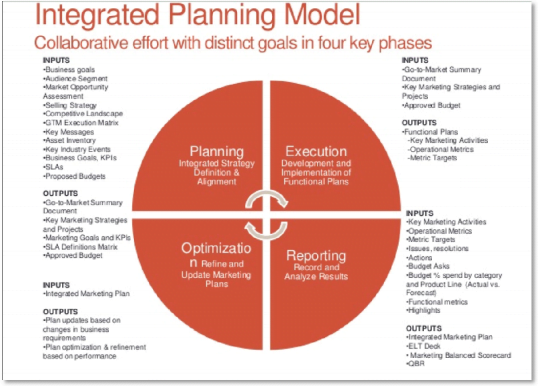
IBP Process Phases
Financial planning phase
Financial planning is the process of building the demand plan at the local and global company level. You will seek to understand, or sense, how your supply chain will need to respond to demand for your products and services. Sensing demand is a key step in avoiding both inventory shortages and overstocked items. Once you have developed a demand plan that is driven by the assortment plan by channel, you will want to be sure that the plan is being fulfilled at least at the departmental level of your organization.
Your demand planners or analysts will then review your forecast against customer service levels and inventory levels at the beginning of each month. This will help your decision-makers sense challenges from more angles so that you can update your forecast accordingly.
Optimization phase
The next step is the process of building a forward-looking aggregated and optimized demand and supply plan at the local and global level. In this step, you will optimize demand with supply, identifying gaps and analyzing alternatives for addressing mismatches, before they affect the customer. You will focus on building a strategic demand plan at the family or sub-family level of your product line, by channel aiming for at least 18-24 months of future visibility for an optimized demand and supply plan.
Execution phase
During execution, you will build strong alignment between your local, regional, and global teams, including the customer and suppliers. Your demand plans and supply forecasts can both be improved through active collaboration with your key stakeholders across your enterprise and beyond. This collaboration should include the merchandising and sales organization, the supply chain, trading partners and suppliers, and most importantly the customer.
Technology is the collaboration enabler. Many leading firms are already using social media to enhance collaboration; this trend will only ramp up in the future. In the execution phase, you will establish departmental coordination as well as ongoing collaboration outside the four walls of your company. It is during the execution process that brings together all executives and stakeholders to approve the optimized demand, supply, and financial plans. Don’t forget, IBP requires buy-in across the organization, as well as, the extended supply chain. At this point, there is a single view of the truth. Everyone in the extended supply chain is operating with the same numbers and the same assumptions.
Do not underestimate the challenge of integration. While it is true that automated workflow and other technologies can help, integration requires process discipline. At the end of the execution step, you will end up with a single, optimized plan. Your financial plans will factor into all your supply chain management decisions.
Reporting phase is continuous
The reporting phase is the process of publishing the integrated plan and adapting to the changes in the business, thus allowing for continuous improvement. It is here we see that building the plan is not enough. Organizations are systems of people and inter- related functions and processes. You must operationalize and disseminate the IBP plan across your extended supply chain to optimize the flow of materials in ways that fulfill demand.
Leveraging a single, integrated IBP platform can dramatically simplify your orchestration process. By the end of the execution phase, you will have achieved global cooperation with all of your trading partners. You will have a responsive supply chain that meets sudden and short-term fluctuations in demand. IBP does not happen overnight, but it does not have to be complicated either.
It is a matter of making continuous improvements to your business processes until you reach supply chain excellence.
-
Rely on a phased approach: IBP is much more an integrated set of business processes and technologies than a single, all-encompassing process or technology. If you just focus on the implementation of a new technology and think that IBP will miraculously take shape, you are wrong.
-
Develop an “outside-in” sequence of IBP initiatives: Typically, the events that will have the most profound and negative impact on your sales and operations planning are those outside of your control. For the most part, these are due to the decisions and actions of your customers, partners, and competitors, which have a direct impact on your revenue and your competitor’s strategy.
-
Focus on more information, less data: Another key to successful IBP is clean, current, and accurate data. Plans are often slowed down by the effort of gathering data that has minimal importance to the overall project. It is important to ensure that you know exactly what business problem you are trying to resolve and understand the minimum data necessary for the project.
-
Provide effective leadership for the process: IBP crosses organizational boundaries, this is its strength but also its vulnerability. Many businesses find that their attempts to implement IBP are frustrated by internal tensions between departments. Classic best practice suggests that IBP must be owned to the Chief Executive Officer. If that is not possible then a strong united coalition of department heads may be able to lead the process if they set clear guidelines, the setting of the overall level of end-to-end planning and other activities to best satisfy the current planned levels of sales (sales plan and/or forecasts). Also, meeting general business objectives of profitability, productivity, competitive customer lead times, etc., as expressed in the overall business plan. One of its primary purposes is to establish receipt flow that will achieve management’s objective of maintaining, raising, or lowering inventories and backlogs, while attempting to keep the workforce relatively stable.
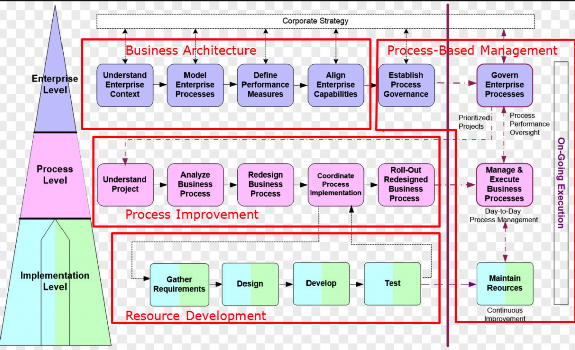
Summary
The agile and flexible organization has the ability to meet the needs of the customer and be the winner at the end of the day.
Organizational success today is driven by high complexities, short product life cycles, and immense pressure to perform. Managers have to make increasingly difficult decisions in less time. These decisions require strong business acumen.
The basic operational value proposition of IBP is the ability to process more with less effort and higher quality. As a result, IBP has become a cornerstone discipline for companies that want to grow revenues quickly, while controlling resource costs and making informed decisions faster.
Business processes are pervasive in any organization. These processes represent all the activities that organizations in all industries undertake. Some processes are highly structured, such as high-volume manufacturing processes, while others, such as medical care that must be tailored to specific patients’ needs, are more unstructured.
You may not think of the activities performed within your organization as business processes, but that is exactly what they are. As you try to improve your operations, you are engaging in a process improvement project. Clearly, you want to leverage advanced methodologies and technologies to deliver consistent, repeatable, and more efficient outcomes as you work on this improvement project. IBP helps you define and manage your business processes so you can reach your desired business goals.
-
Reaching the global market: IBP can help you streamline and scale your supply chain operations, so you can take advantage of opportunities no matter where they may exist.
-
Achieving compliance: Keeping up with complex compliance, regulatory, and corporate governance requirements can be very costly and time-consuming. Using IBP enables you to contain and keep costs under control.
-
Accelerating innovation: You need a business environment where innovation is not only encouraged but also where innovation is a normal part of daily operations.
Improve flexibility: Market demands seem to change almost overnight making flexibility and agility one of the primary keys to success today.
By using IBP, you not only improve your current processes, but also you build and deploy new capabilities and improve your Return On Investment (ROI). In fact, by implementing IBP you would be able to make the necessary improvements faster, at a much lower cost, to better leverage existing resources, thus having an even more positive effect on ROI.
With IBP, the benefits go beyond what you may expect. For example, your customers are likely to see improved customer service and satisfaction, while your partners and suppliers will experience improved communications, faster response, and an organization that is generally easier to do business with.
IBP positions your company to take advantage of new opportunities in ways that simply are not possible currently. Whether you choose to optimize current operational processes to get started with IBP, you will need to begin by evaluating your company’s needs. Any successful process improvement initiative must start with and be driven by business value understanding the business goals and strategies that drive the process improvement initiative. Strategy must be clearly defined to drive the process.
The objective of IBP (with what-if analysis capabilities) is to improve business decision- making as part of the IBP process. Innovative companies, which have deployed IBP, have realized the following benefits:
-
Up to 1% of revenue in additional operating profits.
-
Working capital reductions of 15-25%.
-
Significant risk reduction.
-
IBP surfaces issues, while considering all business constraints, and helps manager’s focus on the business opportunities of greatest significance.
-
Initiates operational change from a “Reactive to Proactive” business process.
-
Operational processes can make better use of technology and the entire enterprise would become more responsive, helping to meet goals and profit objectives.
Companies that implement IBP are more efficient, more effective, and make more money than those who do not.
The key to success in implementing IBP takeaways
-
People are fundamental.
-
Collaboration drives behavioral change.
-
Create internal experts within the company.
-
Develop multi-disciplined teams.
-
Consistent processes with clear responsibilities and accountabilities.
-
Deliver outstanding sustainable results through the integration of business processes and functions, and executive lead and managed IBP.
-
Formal integration with financial planning analysis.
-
Product and portfolio visibility review.
-
Risk management-visibility and management of risks.
-
Planning, Planning, Planning, a critical success factor.
-
Ability to support capture of strategic plans/initiatives.
-
Improved trust and participation across the entire management team and supply chain.
-
Monetized IBP, looking for margin improvement and ROI in the business.


